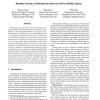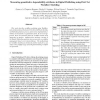106
Voted
DASC
2006
IEEE
15 years 2 months ago
2006
IEEE
Wireless Sensor Networks (WSNs) are severely constrained in computation and communication capabilities due to the cost and size of available sensors. On the other hand, autonomic ...
116
click to vote
DASC
2006
IEEE
15 years 4 months ago
2006
IEEE
We present a new approach to ensure the secure execution of itinerary-driven mobile agents, in which the specification of the navigational behavior of an agent is separated from t...
112
Voted
DASC
2006
IEEE
15 years 4 months ago
2006
IEEE
Run-time monitoring is a powerful approach for dynamically detecting faults or malicious activity of software systems. However, there are often two obstacles to the implementation...
DASC
2006
IEEE
15 years 6 months ago
2006
IEEE
We examine the feasibility of quantitatively characterizing the vulnerabilities in the two major HTTP servers. In particular, we investigate the applicability of quantitative empi...
111
click to vote
DASC
2006
IEEE
15 years 6 months ago
2006
IEEE
Blade severs are being increasingly deployed in modern datacenters due to their high performance/cost ratio and compact size. In this study, we document our work on blade server b...
121
Voted
DASC
2006
IEEE
15 years 6 months ago
2006
IEEE
Abstract— Wireless Sensor Networks (WSNs) have critical applications in diverse domains like environmental monitoring and military operations where accurate location of sensors i...
121
Voted
DASC
2006
IEEE
15 years 6 months ago
2006
IEEE
Abstract— In stream authentication protocols used for largescale data dissemination in autonomuous systems, authentication is based on the timing of the publication of keys, and ...
136
Voted
DASC
2006
IEEE
15 years 6 months ago
2006
IEEE
Abstract— This paper describes Service Clouds, a distributed infrastructure designed to facilitate rapid prototyping and deployment of services that enhance communication perform...
162
Voted
DASC
2006
IEEE
15 years 6 months ago
2006
IEEE
— Honeypots are decoys designed to trap, delay, and gather information about attackers. We can use honeypot logs to analyze attackers’ behaviors and design new defenses. A virt...
96
Voted
DASC
2006
IEEE
15 years 6 months ago
2006
IEEE


